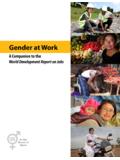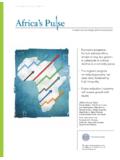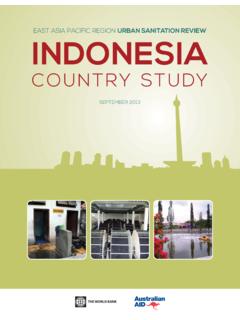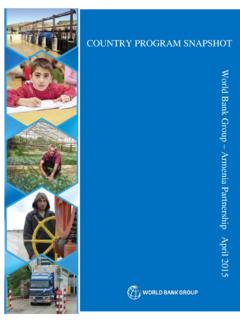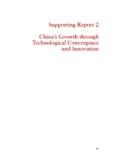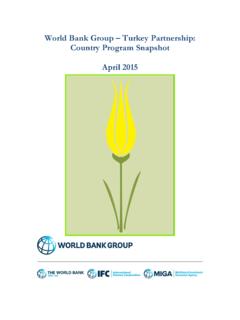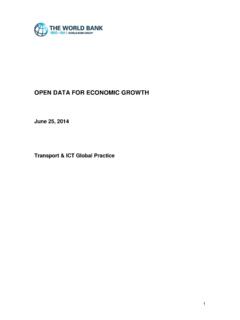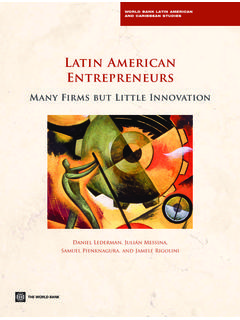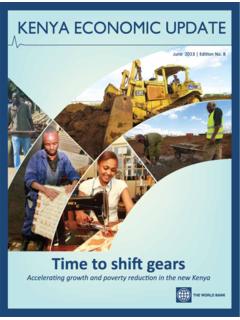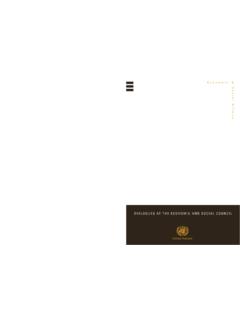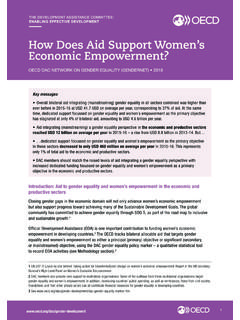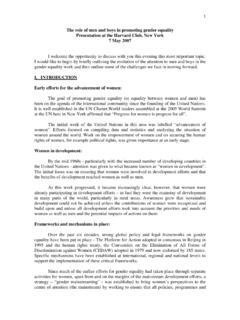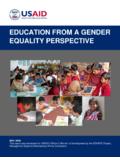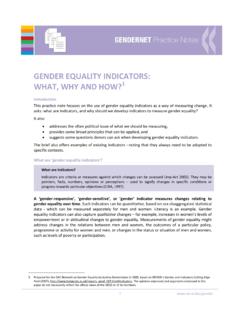Transcription of LAND TENURE AND GENDER: APPROACHES AND …
1 women 's Voice, Agency, & Participation Research Series 2014 LAND TENURE AND gender : APPROACHES AND CHALLENGES FOR STRENGTHENING RURAL women 'S. LAND RIGHTS. Evelyn Namubiru-Mwaura, PhD. This paper was commissioned by the world bank Group to help inform a forthcoming report on women 's voice, agency, and participation. It does not necessarily reflect the views and research of the world bank Group. Feedback and comments are welcome at: More details about the report are available at: i|Page Table of Contents Abstract .. ii List of Acronyms .. iv Introduction .. 1. Rationale for women 's Land Rights .. 2. Status of women and Land Ownership .. 4. Institutions and Their Impact on women 's Land Rights.
2 7. Some Emerging APPROACHES in Addressing women 's Land Rights .. 15. Policy and Programmatic Implications and Recommended Actions .. 21. Conclusion .. 24. ABSTRACT. Land TENURE security is crucial for women 's empowerment and a prerequisite for building secure and resilient communities. TENURE is affected by many and often contradictory sets of rules, laws, customs, traditions, and perceptions. For most rural women , land TENURE is complicated, with access and ownership often layered with barriers present in their daily realities: discriminatory social dynamics and strata, unresponsive legal systems, lack of economic opportunities, and lack of voice in decision making. Yet most policy reform, land management, and development programs disregard these realities in their interventions, which ultimately increases land TENURE insecurity for rural women .
3 This paper seeks to further develop the evidence base for access to and control over land. In its 2012. world Development Report: gender Equality and Development, the world bank states that women 's agency is a key dimension of gender equality and that having a voice in society to influence policy is one expression of agency. A contributory factor to women 's empowerment that would go a long way in raising their voices is improved access to, and control over, land. I draw on existing evidence and new data to show how women 's ownership of land and property can be potentially transformative, not only as a store of value but also as a means of acquiring other assets and engaging in a range of markets.
4 The following key lessons emerge from this background paper: women play a critical role in supporting their households and communities in achieving food and nutrition security and overall well-being. women 's ownership of land and property can be potentially transformative, not only as a store of value but also as a means of acquiring other assets and engaging in other businesses. Reducing barriers to women 's control of rural resources, particularly land, is critical in the fight against poverty. Rights to land may derive from the state, but they can also derive from a range of customary and religious laws, through inheritance and through marriage. In rural settings, customary norms and religion are often more important in determining women 's rights than statutory laws.
5 Ii | P a g e Statutory land reforms have been enacted in many developing countries with the aim of empowering all land users, including women . Although they tend to be gender neutral and provide for equal rights to both men and women , they are often not implemented effectively and can be ineffective where customary regimes prevail. gender -neutral regulations can be ineffectively implemented even where there are no conflicting customary regimes. Customary norms continue to limit rural women 's ownership and control of land. Despite some positive steps toward reforming land laws and policies in many developing countries, women 's rights to land have yet to become fully realized and the reality for women is still characterized strongly by entrenched patterns of exclusion.
6 Consequently, many rural women still do not own, control, or inherit land. No single land policy or strategy can address land TENURE problems for women in rural areas. Policy reforms and any other interventions must be tailored to the physical, social, and economic contexts. The challenge is to find appropriate reforms or interventions that take into consideration economic factors, issues of equity, and less tangible concerns such as the social or religious beliefs that people attach to land. There is a paucity of consolidated and synthesized data on women 's land rights, especially in rural areas. While some interventions seem promising, not enough information is available to confirm their effectiveness in addressing women 's land rights in rural areas.
7 Furthermore, although many different case studies on innovative ways of securing women 's land TENURE in rural areas have been carried out, they tend to be isolated and unclassified. Information on new and effective ways of addressing land TENURE security for rural women is important if past mistakes are to be avoided and promising APPROACHES taken up. iii | P a g e List of Acronyms CGIAR Consultative Group on International Agricultural Research COHRE Centre on Housing Rights and Evictions ECA East and Central Asia FAO Food and Agriculture Organization of the United Nations ICRW International Center for Research on women IFAD International Fund for Agricultural Development IFPRI International Food Policy Research Institute NGO Nongovernmental organization RDI Rural Development Institute ULA Uganda Land Alliance UNDP United Nations Development Programme UN-HABITAT United Nations Human Settlements Programme iv | P a g e Introduction In many developing countries, where most rural poor rely on subsistence agriculture for their survival.
8 Land remains a critical asset (FAO 2010b). Small-scale food production and the women involved in it are the backbone of rural livelihoods: women farmers produce more than half of all the food grown in the world and 60 to 80 percent of the food grown in most developing countries (FAO 2010b, 2011; Oxfam 2013). Access to and control of property, whether customary, statutory, or religious, provide economic entry for women to key markets as well as social access to non-market institutions such as household- and community-level governance structures, where they can contribute to decision making (COHRE 2004). Without land, such opportunities are difficult or impossible for women to attain since land provides them with a basic means for subsistence and market production (FAO 2010b).
9 women make up 43 percent of the agricultural labor force worldwide ( world bank 2012b), although many work without pay. A study by the world bank (2008) indicates that in Sub-Saharan Africa, where national economies are mostly agriculture-based, farming on their own land was found to be the most common form of employment for both sexes (about 56 percent and 54 percent of male and female adults, respectively). This is followed by non-agricultural wage work for men (9 percent) and non-agricultural self-employment for women (7 percent). The study also found that African women are more likely than African men to be self-employed in the agricultural sector ( world bank 2008). If rural women had the same access to productive inputs as men, they could increase yields on their farms by 20 to 30 percent, raising total agricultural output in developing countries by to 4 percent and, in turn, reducing the number of hungry people in the world by 12 to 17 percent (FAO 2011).
10 Unfortunately, gender disparities in land access remain very high around the world , regardless of a region's level of development (FAO 2010a). Some women , individually or in groups, own land on which they produce food and goods for their families, products to sell, or rental income, although their ownership is not legally recognized. In these cases, they may or may not control the decisions made about the use of the land, depending on how important their production and income is to their spouses, households, or other legal owners. Others may own property through a joint title with a husband or another family member and again may or may not control land use decisions. If the tally of female land ownership in Africa, for example, is based on jointly or individually titled land, the percentage would be very low because levels of titled land ownership are very low, even for men (Cheryl Doss interview in Horan 2013).
